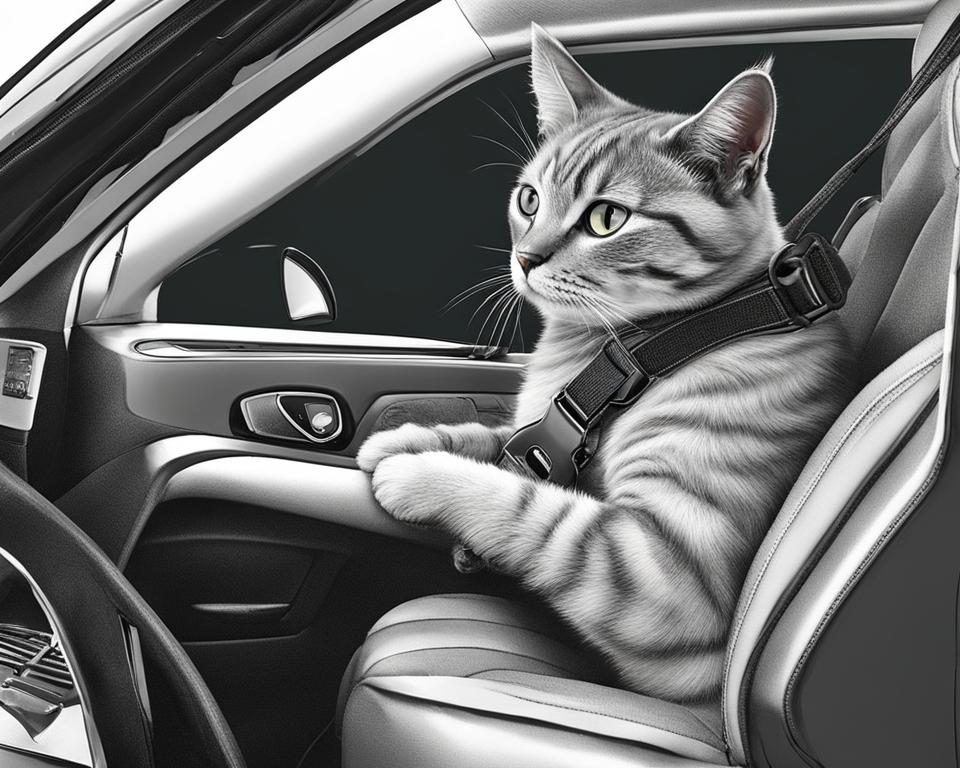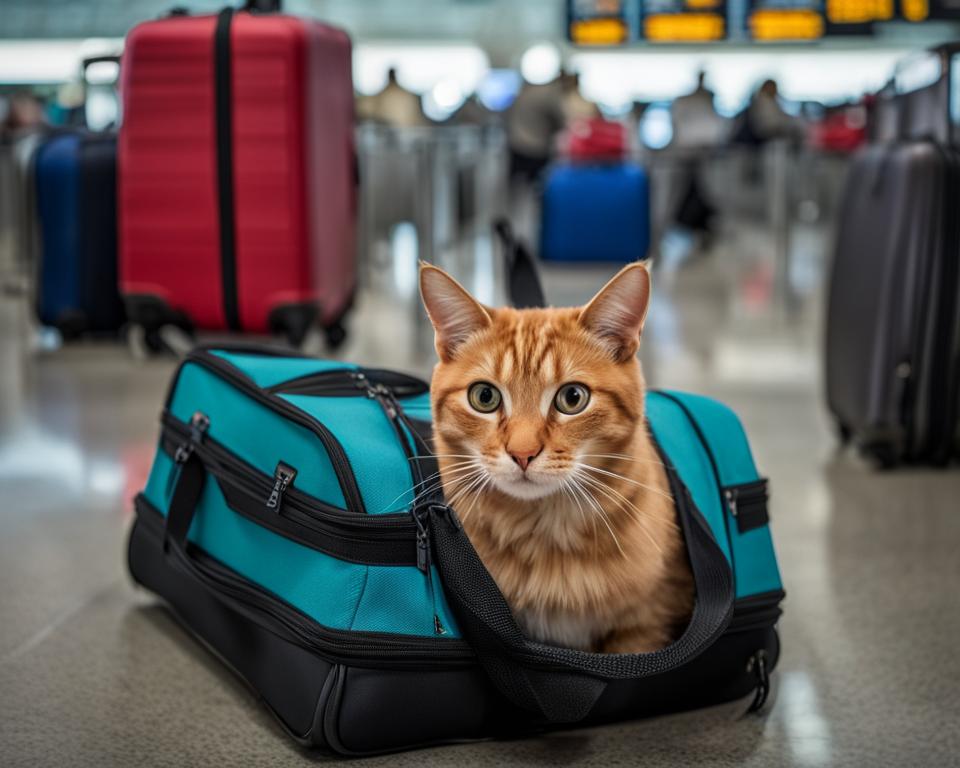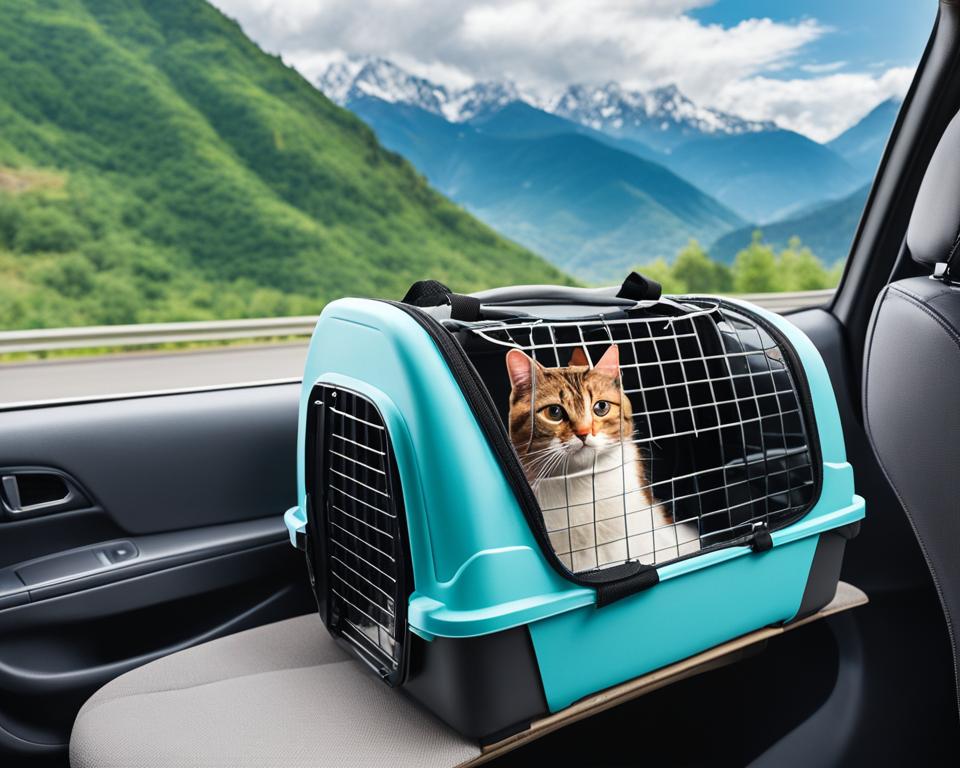Embarking on a journey with your feline companion can seem daunting. When the question arises, is it cruel to travel with a cat, the answer is not one-size-fits-all. Traveling with pets, particularly cats, can indeed induce stress, but with the right preparation and pet travel safety measures, it can also be a smooth and comfortable experience for both of you. A critical part of making travel cat-friendly is ensuring a well-ventilated and appropriately sized carrier is available, as well as acclimating your cat to this temporary habitat in advance.
Picture this: You and your cat, hitting the open road, prepared for an adventure. Preparation is your golden ticket, minimizing stress with the help of products like Comfort Zone® with Feliway® and embedding scents that are familiar to your cat within its carrier. This thoughtful approach is the cornerstone of creating a stress-free travel experience for your beloved pet. Let’s ensure your whiskered companion’s journey is as enjoyable as your destination.
Key Takeaways
- Identify your cat’s comfort level with travel prior to embarking on a trip.
- Invest in a proper carrier that ensures both safety and comfort for your cat.
- Familiarize your cat with the carrier to mitigate travel-induced stress.
- Pack a pet travel kit with essentials to create a homely space for your feline friend.
- Maintain updated contact information and consider microchipping for extra security.
- Acclimate your cat through short pre-trip drives and establish a calming pre-journey routine.
Understanding Your Cat’s Travel Temperament
When it comes to traveling with cats, recognizing individual temperament is crucial for a smooth journey. Unlike humans, who express readiness for travel differently, cats communicate their acceptance or stress through subtle and not-so-subtle cues. It is vital to be well-informed about these indications to ensure a gratifying travel experience for both you and your feline companion.
Identifying Stress Signs in Felines
Stress can manifest in various ways within different cats. Look out for signs like excessive meowing, pacing, or even changes in eating habits as they could indicate discomfort with the concept of travel. Reducing stress for traveling cats starts with recognizing these stress signals early and taking action to mitigate them.
Assessing Your Cat’s Comfort with Travel
Your cat’s pre-travel behavior can offer invaluable insights into their potential comfort with traveling. Introduce them to their carrier and take them on short car rides, observing their reactions. Are they curious and calm, or do they seem anxious and try to escape? Their reaction can help you tailor your cat travel tips and preparations to suit their preferences.
Considering Age and Health Factors
Age and health are significant factors when it comes to how stress-free travel can be for a cat. Kittens and senior cats tend to be more vulnerable to the rigors of travel, as do cats with health concerns. Before planning a trip, contemplate whether your cat’s age or health condition might impact their ability to cope with the stress of travel. Consultation with a veterinarian can provide further guidance on how to proceed.
Familiarization with travel carriers and harnesses in a non-threatening environment plays a pivotal role in reducing stress for traveling cats. By allowing your cat to view the carrier as a safe space, you set the stage for a more serene travel experience. Gather tips and develop a plan to make your feline’s travel as comfortable as possible, whether it’s a quick trip to the vet or a longer vacation.
| Age Group | Suggested Preparations | Notes on Comfort Levels |
|---|---|---|
| Kittens | Short, playful exposure to carriers and vehicles | May adapt quicker but need comfort items |
| Adult Cats | Gradual acclimation to travel conditions | Varied reactions, observe closely |
| Elderly/Special Needs Cats | Consultation with vet, consider medical aids | May require more comfort aids and breaks |
Ultimately, understanding your cat’s individual needs and responses is paramount. With careful observation and consideration, you can ensure that traveling with cats is a positive experience for all involved.
Preparing Your Cat for the Trip
Embarking on a journey with your cat can be a delightful experience, provided you take the necessary steps to ensure a smooth pet journey. Effective preparation is key to creating a cat-friendly travel environment. This includes conditioning your cat to the travel experience, so that the trip can be as stress-free and enjoyable as possible for both of you. Here’s your guide to traveling with pets that touches on everything from carrier comfort to the importance of identification.
Begin the travel conditioning process by taking your pet on short drives that progressively increase in time. These mini-experiences can greatly assist in building your cat’s comfort and familiarity with travel. To curb the possibility of motion sickness—a common concern for traveling felines—make sure to feed your cat at least three hours before departure. Moreover, during the travel, prioritize safety by securing your cat in a well-ventilated carrier in the backseat, away from the potential hazard of front-seat airbags.
- Update Identification Tags: Always ensure your cat’s identification tags are current. This is a crucial step in pet travel safety should your feline friend accidentally slip away during travel.
- Never Leave Your Cat Alone: A parked vehicle can be a dangerous environment for an animal. Ensure you never leave your cat alone—regardless of weather conditions or duration.
Packing a well-thought-out pet travel kit is essential and should cover all bases to mirror the comforts of home. Your cat’s travel kit should include, but not be limited to, the following items:
| Category | Items |
|---|---|
| Food & Water | Portable dishes, their regular food, and bottled water |
| Bedding | Favorite blanket or bed for a sense of security |
| Waste Management | Litter box, scoop, and plastic bags for clean-up |
| Medication | Any prescribed medications and a basic first-aid kit |
| Entertainment | Toys and treats to keep them occupied and happy |
Adhering to these pet journey tips will not only make traveling with your cat an actual possibility, but it will also enhance your experience as you create memorable moments with your beloved pet. Remember, preparation is your best ally when it comes to cat-friendly travel.
Essential Pet Travel Safety Measures

Ensuring pet travel safety starts with a well-thought-out plan that covers all aspects of your journey, whether you’re taking to the skies for air travel with cats or embarking on road trips with cats. Let’s guide you through some pivotal steps to make traveling with your feline friend as smooth as possible.
Choosing the Right Carrier
Your cat’s travel home significantly impacts their comfort and safety. A carrier should be spacious enough for your cat to stand, turn around, and lie down, yet secure and easy to transport. Ventilation is key for air circulation and stress reduction.
Securing Your Pet During Transit
Diligence in securing your cat’s carrier in the vehicle prevents it from shifting and protects your pet in the event of sudden stops. When considering air travel, review airline pet policies to ensure compliance with standards for securing pet carriers.
Addressing Food and Comfort Needs
Travel can disrupt your cat’s routine, so it’s essential to provide familiar comforts. Packing items from home, such as toys or blankets, can ease stress, while managing feeding times helps to prevent carsickness.
| Travel Item | Importance | Tips |
|---|---|---|
| Carrier | Essential for containment and safety | Select a carrier with ample space and stability |
| Restraints | Guarantees pet is secure during transport | Use a harness or carrier belt for added security |
| Comfort Items | Reduce anxiety and provide familiarity | Include a favorite toy or blanket |
| Food and water | Maintain hydration and prevent hunger | Limit food intake before travel to avoid sickness |
Is It Cruel to Travel with a Cat?

For many cat owners, the decision to travel with their feline companion is not taken lightly. Whether it’s a vacation or a move, the concern about whether it’s cruel to travel with a cat often arises. To address these concerns, understanding the nature of your cat’s behavior during travel and taking proactive steps can greatly reduce stress for both you and your pet.
Evaluating the Need Versus the Impact on Your Cat
When planning your trip, consider if the presence of your cat is necessary. Think about the length of the trip and the possible benefits of having your cat with you versus the stress it might cause. If traveling is unavoidable, preparation and understanding your cat’s needs can go a long way in ensuring their well-being.
Behavioral Concerns During Travel
Behavioral changes in cats can be significant when they are taken out of their comfort zone. The uncertainty associated with new environments, long periods of confinement, and changes in routine can all be sources of distress. It’s crucial to monitor your cat for any signs of anxiety or motion sickness and take appropriate action to alleviate these issues.
| Behavioral Concern | Signs to Watch For | How to Help |
|---|---|---|
| Anxiety | Pacing, increased meowing, or withdrawal | Keep a familiar item with your cat, such as a blanket or toy |
| Motion Sickness | Vomiting, drooling, or unease | Consult your vet about motion sickness remedies |
| Aggressiveness | Hissing, swatting, or biting | Use a calming pheromone spray in the carrier |
Remember that every cat is unique, and behavioral concerns during travel can take different forms. Always prioritize your cat’s comfort and safety, and when in doubt, seek advice from a veterinarian who can offer personalized strategies to help your cat cope better with the journey ahead.
Alternatives to Traveling with Your Cat
Understanding that not all cats are suited for travel is key in safeguarding their well-being. When weighing the options for alternatives to cat travel, engaging a professional cat sitter is a stellar choice for many pet parents. A sitter can seamlessly blend into your cat’s daily life, keeping everything from meal times to play sessions as regular as clockwork. Prior to your departure, consider arranging a mock care session; this allows the sitter to familiarize with your pet’s personality and specific needs. It also gives you the opportunity to provide comprehensive care instructions and go over an emergency action plan—preparing both your cat and the sitter for any possible contingencies.
In instances where professional in-home care might not cut it, pet owners have the choice of utilizing boarding services, such as those provided by vet clinics or upscale pet hotels. These facilities often come equipped with trained staff, ensuring your feline friend receives the necessary medical attention alongside daily love and care. When exploring these venues for your cat, pay attention to reviews and possibly visit in person to gauge the cleanliness, space, and the general ambiance of the facility. Remember, the objective is to find a substitute for the comfort and sanctity of your home.
Ultimately, whether you’re considering traveling with pets or finding alternatives, the health and happiness of your cat should always take center stage. Assessing all available options lets you tailor a solution that best suits the individual needs of your furry companion, ensuring peace of mind for you both while you’re away. Traveling with cats or choosing to leave them in capable hands, the right selection can make all the difference to the well-being of your cherished pet.
FAQ
Is it cruel to travel with a cat?
Whether traveling with a cat is considered cruel depends on the cat’s temperament, health, and how well its needs are met during travel. With proper preparation, familiarization, and safety measures, traveling can be a stress-free experience for your cat. However, if a cat is particularly anxious, elderly, or unwell, it may be kinder to consider alternatives to travel.
What are the signs of stress in traveling cats?
Signs of stress in cats during travel can include excessive meowing, panting, shaking, vomiting, changes in behavior such as aggression or withdrawal, and loss of appetite. Monitoring for these signs is essential for ensuring your cat’s well-being during travel.
How can I assess my cat’s comfort with travel?
Begin with short trips in a secure carrier to gauge your cat’s reaction. Observe their behavior and look for any signs of stress or discomfort. Some cats may gradually become more comfortable with travel over time, while others may not adjust as well.
Should I consider my cat’s age and health before deciding to travel?
Yes, age and health are significant factors in determining travel suitability for a cat. Kittens, senior cats, or those with pre-existing health conditions may find travel more stressful or unpleasant. Consult with your veterinarian to assess whether travel is safe for your cat.
How can I prepare my cat for a trip?
Prepare your cat by introducing the carrier well in advance of the trip. Practice short drives, progressively increasing the time as your cat becomes more comfortable. Pack a travel kit with familiar items and plan for regular breaks during longer travels.
What are the essential pet travel safety measures?
Essential safety measures include choosing an appropriate-sized, well-ventilated carrier, securing the carrier safely in the vehicle, ensuring your cat has a proper identification tag or microchip, and never leaving your cat alone in a parked car. Also, prevent motion sickness by managing feeding times before travel.
How do I choose the right carrier for air or road travel with cats?
Select a carrier that is sturdy, well-ventilated, and large enough for your cat to stand, turn around, and lie down comfortably. For air travel, ensure the carrier is airline approved. For road trips, secure the carrier in the backseat away from airbags.
How do I secure my pet during transit?
Place the carrier on the floor behind a seat or securely fasten it with a seatbelt in the backseat. Avoid placing the carrier on the front seat due to the risk of airbags. Consider using a harness and leash during breaks for added security.
How can I address my cat’s food and comfort needs while traveling?
Provide water and small meals based on your cat’s usual feeding schedule, and avoid feeding immediately before or during travel to prevent motion sickness. Include familiar items like a favorite blanket or toy in the carrier to provide comfort and a sense of security.
How do I evaluate the need for travel versus the potential impact on my cat?
Consider the purpose of the travel, the length of the trip, and whether your destination will be a stable environment for your cat. Also, weigh the potential stress and impact on your cat’s behavior and health. If the journey is not essential or potentially distressing, alternative care arrangements may be more appropriate.
What behavioral concerns should I consider when traveling with my cat?
Monitor your cat for signs of increased anxiety, aggression, withdrawal, or motion sickness. Consult with your veterinarian beforehand if your cat has a history of travel-related stress, and discuss options such as counterconditioning or medication if necessary.
What are some alternatives to traveling with my cat?
Alternatives include hiring a professional cat sitter to care for your cat in its home environment or using boarding facilities like pet hotels or veterinarian clinics. Whichever option you choose, make sure it provides the care and stability your cat needs in your absence.

